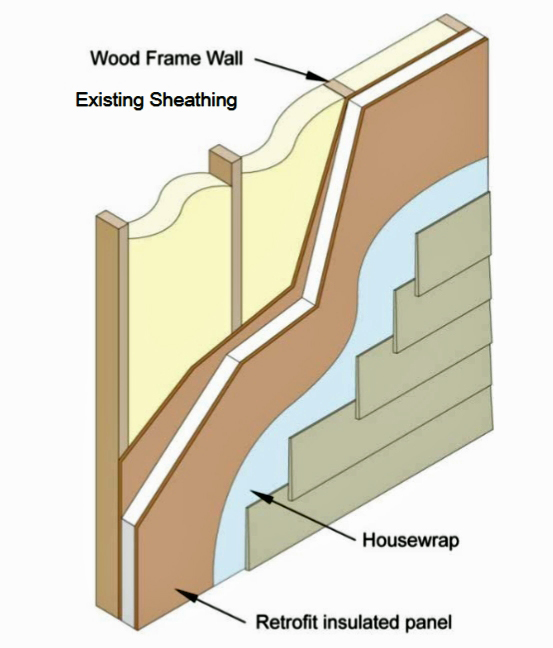
Image Credit: U.S. Department of Energy
These days, lots of builders are installing a continuous layer of rigid foam on the exterior side of their wall sheathing. The usual approach is to sheathe the wall with OSB or plywood, and then to install one or more layers of rigid foam outboard of the sheathing.
Some builders are beginning to simplify this process by switching to nailbase panels — rigid foam panels with a layer of OSB or plywood glued to one side. Since nailbase panels provide sheathing and foam insulation in a single panel, they should (in theory) simplify the construction process.
Although nailbase panels were originally developed for use on roofs, an increasing number of nailbase manufacturers are beginning to realize that they can also market their products for use on walls.
At least four manufacturers have developed nailbase-like panels designed specifically for walls:
- Styrofoam SIS panels from Ox Building Products;
- Zip-R panels from Huber Engineered Wood;
- ThermalStar LCi-SS from Atlas EPS; and
- Insulfoam ci Panel from Premier SIPs.
In addition to these three products, a great many brands of nailbase panels designed for roofs are now being marketed for use on walls.
This article will attempt to address several technical questions surrounding the use of nailbase panels on walls, including these:
- Should the rigid foam face the exterior or the interior?
- Can nailbase panels be used to brace a wall?
- What’s the minimum R-value for a nailbase panel in Climate Zone 4? Zone 5? Zone 6? Zone 7?
- Does this type of panel limit siding choices?
Styrofoam SIS
Dow Building Products introduced SIS (“structural insulated sheathing”) panels in 2008. Four years later, in July 2012, Dow stopped making the product; however, another company, Ox Building Products of Constantine, Michigan, obtained the licensing rights to SIS and is now manufacturing and distributing the panels under the name Styrofoam SIS.
SIS panels…
Weekly Newsletter
Get building science and energy efficiency advice, plus special offers, in your inbox.

This article is only available to GBA Prime Members
Sign up for a free trial and get instant access to this article as well as GBA’s complete library of premium articles and construction details.
Start Free TrialAlready a member? Log in















7 Comments
Styrofoam SIS - High Wind Area
I was looking at this product for possible use on house near ocean in "high wind" area, but you indicate they cannot be used unless "part of engineered design" . Can you explain what those provisions would be where you could use this product? Thanks.
Response to Steve Kreisher
Steve,
I'm not an engineer, so I'm not going to speculate on how to meet your goals for a building in a high wind area. The best approach would be to talk to an engineer.
You might also want to discuss the question with someone in the manufacturer's technical help department. Here is the contact information:
Ox Building Products
700 Centreville Road
Constantine, MI 49042
269-435-2425
800-345-8881
Thicker ZIP-R Products
In case it's useful to anyone, here are some snapshots of the thicker ZIP-R samples at a trade show.
HI,
DOes anyone have any experience with the Hunter Xci ply panels?
Thanks
ANdy
Hi there,
I'm considering using the Zip R6 sheathing in a zone 6 location in Colorado. Since the zip system puts the sheathing on the outside of the wall, does the "minimum thickness of foam" rule of thumb apply? It seems like the sheathing would be able to dry to the exterior eliminating the issue of moisture accumulation. Is this thought process correct?
Thanks!
User 6997503,
You'll hear different opinion on this, but here's my answer: If the layer of rigid foam in the Zip R sheathing is too thin, then the interior surface of the rigid foam becomes the first condensing surface for humid indoor air. If the foam is too cold, the first condensing surface will be too cold, and condensation could conceivably accumulate, run down the foam, and puddle on the bottom plate.
I'm conservative on these rules. I'd advise you to stick by the "minimum thickness of foam" rule, even for Zip R sheathing.
Thanks for your quick response! As always, very helpful!
Log in or become a member to post a comment.
Sign up Log in